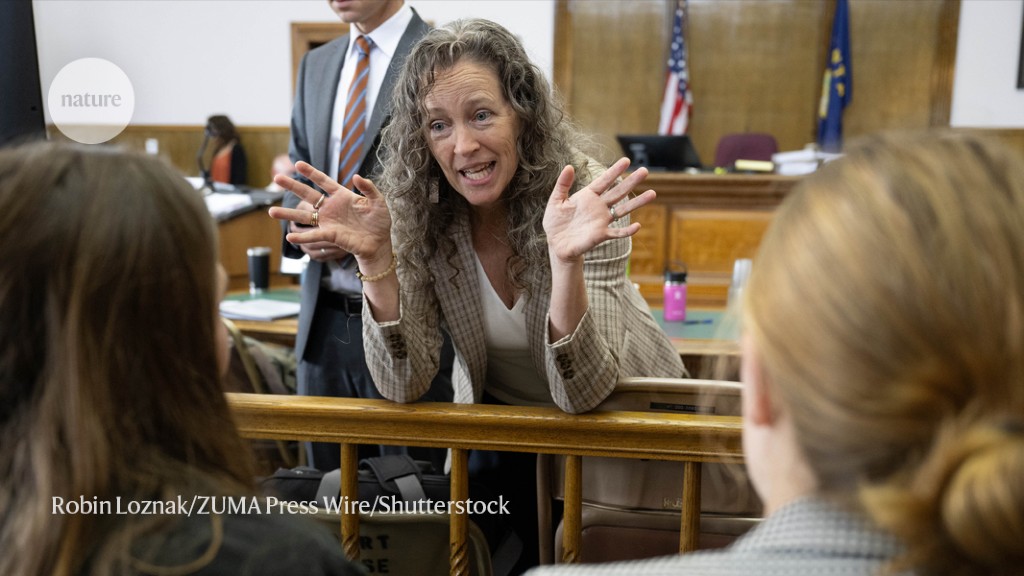‘Truly historic’: How science helped kids win a landmark climate trial

Lead attorney Julia Olson lays out what’s needed for future victories

Julia Olson talks with plaintiffs in the Held v. Montana climate-change lawsuit.Credit: Robin Loznak/ZUMA Press Wire/Shutterstock
Advocates for action on climate change won a major court victory in the United States this week. A district court judge ruled in Held v. Montana that the state’s Environmental Policy Act, which prohibits considering the climate impact of proposed energy projects, violates the “right to a clean and healthful environment” promised by the state’s constitution. Montana’s attorney general has vowed to appeal.
The case was brought in 2020 on behalf of a group of 16 young people, now ages 5–22 years old, and was litigated by Julia Olson at the nonprofit law firm Our Children’s Trust. Olson has been involved with dozens of climate cases since around 2010. She spoke to Nature from her home office in Eugene, Oregon, which was under both an excessive heat warning and an air-quality warning for wildfire smoke and smog at the time of the call.
How are you holding up?
The air purifier is going.
What are the implications of your win this week in Montana?
I think this decision out of Montana is truly historic. I think it will be seen as the first big win on what’s called the merits of the case.
The right to a clean, clean and healthful environment is explicitly written in the Montana constitution. And maybe a dozen constitutions in the United States have similar provisions. What the court said in Held v. Montana is that there is a climate right that exists for these youths.
We have a state system, and then there’s a federal system. And when you look at other civil rights movements, like desegregation or gay marriage, oftentimes, the cases at the state level happen first, and then it builds across the country — ultimately to the federal level, where we have a case pending currently, Juliana v. United States.
You’ve been litigating for children’s right to a stable and healthy climate for 13 years now. What is the role of science in your cases?
The science is foundational to our cases, and we bring in the best science we can through expert testimony. The people we work with — like the experts who testified in Montana on behalf of the plaintiffs — most have never testified in court before. What was just amazing was having these world-renowned scientists take the stand and tell the story of the work they’ve been doing for large parts of their career and just feel so validated. Mark Jacobson from Stanford, he actually said on the stand something like, “I’m just a scientist; nobody listens to me.” We heard from many of our experts that it was such an empowering experience to be able to present the science in the court of law under oath, under cross examination, and to do that for these youths.
Are there any gaps in the science that you would like to see filled, that would help you in your work building a case that emitting carbon violates children’s civil rights?
When we started this, there wasn’t nearly as much science around public health and the impacts of climate change on young people, the way children are disproportionately harmed by various aspects of the climate crisis. There’s always more work that can be done there. It would be great to have studies in specific places, like Oregon, looking at where children live, the ways they’re being harmed by heat and fire and smoke and drought, and displacement. That kind of scientific research is really helpful. For example, there’s more and more now coming out about the smoke plumes and what it’s going to do to respiratory health and long-term health of children.
What about research around specific targets, like the 1.5 °C average warming target in the Paris agreement?
A lot of scientists are now doing research focused around the 1.5 °C target, sort of without even thinking hard about it, thinking, “Oh, that’s the standard.” Getting hotter is not the solution! It will just cause more harm to young people and violate more human rights across the globe. The best available science shows that we need to get below [an atmospheric carbon concentration of] 350 parts per million to restore the Earth’s energy imbalance. And there’s not enough science looking at that. What if we got back to 350? Then what will our world look like? And how quickly do we think the temperatures can start coming down? We need science that will inform the world we want to create.
When will you feel that your own work is done? When will you have “won”?
When we win against the United States government, and they are told that the United States fossil fuel energy system is unconstitutional, then I’ll be able to take a little bit of a breather.
doi: https://doi.org/10.1038/d41586-023-02592-8
This story originally appeared on: Nature - Author:Emma Marris


















